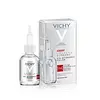What's inside
What's inside
 Key Ingredients
Key Ingredients

 Benefits
Benefits

 Concerns
Concerns

No concerns
 Ingredients Side-by-side
Ingredients Side-by-side

Water
Skin ConditioningGlycerin
HumectantHydroxyethylpiperazine Ethane Sulfonic Acid
BufferingSodium Hyaluronate
HumectantPEG-60 Hydrogenated Castor Oil
EmulsifyingWater, Glycerin, Hydroxyethylpiperazine Ethane Sulfonic Acid, Sodium Hyaluronate, PEG-60 Hydrogenated Castor Oil, Secale Cereale Seed Extract, Calcium Pantothenate, Dipeptide Diaminobutyroyl Benzylamide Diacetate, Phenoxyethanol, Chlorphenesin, Ascorbyl Glucoside, Disodium EDTA, Pentylene Glycol, Ceramide AP
Water
Skin ConditioningGlycerin
HumectantEthylhexyl Salicylate
UV AbsorberEthylhexyl Triazone
UV AbsorberAlcohol Denat.
AntimicrobialBis-Ethylhexyloxyphenol Methoxyphenyl Triazine
Skin ConditioningDimethicone
EmollientLauroyl Lysine
Skin ConditioningButyl Methoxydibenzoylmethane
UV AbsorberOctyldodecanol
EmollientBehenyl Alcohol
EmollientIsopropyl Isostearate
EmollientPerlite
AbsorbentAluminum Starch Octenylsuccinate
AbsorbentCetyl Alcohol
EmollientHydrolyzed Rice Protein
Skin ConditioningAdenosine
Skin ConditioningCapryloyl Salicylic Acid
ExfoliatingDisodium EDTA
Hydroxyacetophenone
AntioxidantPalmitoyl Tetrapeptide-7
Skin ConditioningPalmitoyl Tripeptide-1
Skin ConditioningSodium Acetylated Hyaluronate
HumectantSodium Hyaluronate
HumectantNiacinamide
SmoothingTocopherol
AntioxidantAcrylamide/Sodium Acryloyldimethyltaurate Copolymer
Emulsion StabilisingAmmonium Polyacryloyldimethyl Taurate
Emulsion StabilisingButylene Glycol
HumectantCarbomer
Emulsion StabilisingCetearyl Alcohol
EmollientCetearyl Glucoside
EmulsifyingIsohexadecane
EmollientMyristic Acid
CleansingPalmitic Acid
EmollientPEG-100
HumectantStearyl Stearate
EmollientPentylene Glycol
Skin ConditioningPoly C10-30 Alkyl Acrylate
Emulsion StabilisingPolysorbate 20
EmulsifyingPolysorbate 80
EmulsifyingSodium Lactate
BufferingSodium Polyacrylate Starch
AbsorbentSodium Stearoyl Glutamate
CleansingSorbitan Oleate
EmulsifyingStearic Acid
CleansingCI 15985
Cosmetic ColorantCI 16035
Cosmetic ColorantPhenoxyethanol
PreservativeParfum
MaskingWater, Glycerin, Ethylhexyl Salicylate, Ethylhexyl Triazone, Alcohol Denat., Bis-Ethylhexyloxyphenol Methoxyphenyl Triazine, Dimethicone, Lauroyl Lysine, Butyl Methoxydibenzoylmethane, Octyldodecanol, Behenyl Alcohol, Isopropyl Isostearate, Perlite, Aluminum Starch Octenylsuccinate, Cetyl Alcohol, Hydrolyzed Rice Protein, Adenosine, Capryloyl Salicylic Acid, Disodium EDTA, Hydroxyacetophenone, Palmitoyl Tetrapeptide-7, Palmitoyl Tripeptide-1, Sodium Acetylated Hyaluronate, Sodium Hyaluronate, Niacinamide, Tocopherol, Acrylamide/Sodium Acryloyldimethyltaurate Copolymer, Ammonium Polyacryloyldimethyl Taurate, Butylene Glycol, Carbomer, Cetearyl Alcohol, Cetearyl Glucoside, Isohexadecane, Myristic Acid, Palmitic Acid, PEG-100, Stearyl Stearate, Pentylene Glycol, Poly C10-30 Alkyl Acrylate, Polysorbate 20, Polysorbate 80, Sodium Lactate, Sodium Polyacrylate Starch, Sodium Stearoyl Glutamate, Sorbitan Oleate, Stearic Acid, CI 15985, CI 16035, Phenoxyethanol, Parfum
Ingredients Explained
These ingredients are found in both products.
Ingredients higher up in an ingredient list are typically present in a larger amount.
Disodium EDTA plays a role in making products more stable by aiding other preservatives.
It is a chelating agent, meaning it neutralizes metal ions that may be found in a product.
Disodium EDTA is a salt of edetic acid and is found to be safe in cosmetic ingredients.
Learn more about Disodium EDTAGlycerin is already naturally found in your skin. It helps moisturize and protect your skin.
A study from 2016 found glycerin to be more effective as a humectant than AHAs and hyaluronic acid.
As a humectant, it helps the skin stay hydrated by pulling moisture to your skin. The low molecular weight of glycerin allows it to pull moisture into the deeper layers of your skin.
Hydrated skin improves your skin barrier; Your skin barrier helps protect against irritants and bacteria.
Glycerin has also been found to have antimicrobial and antiviral properties. Due to these properties, glycerin is often used in wound and burn treatments.
In cosmetics, glycerin is usually derived from plants such as soybean or palm. However, it can also be sourced from animals, such as tallow or animal fat.
This ingredient is organic, colorless, odorless, and non-toxic.
Glycerin is the name for this ingredient in American English. British English uses Glycerol/Glycerine.
Learn more about GlycerinPentylene glycol is typically used within a product to thicken it. It also adds a smooth, soft, and moisturizing feel to the product. It is naturally found in plants such as sugar beets.
The hydrophilic trait of Pentylene Glycol makes it a humectant. As a humectant, Pentylene Glycol helps draw moisture from the air to your skin. This can help keep your skin hydrated.
This property also makes Pentylene Glycol a great texture enhancer. It can also help thicken or stabilize a product.
Pentylene Glycol also acts as a mild preservative and helps to keep a product microbe-free.
Some people may experience mild eye and skin irritation from Pentylene Glycol. We always recommend speaking with a professional about using this ingredient in your routine.
Pentylene Glycol has a low molecular weight and is part of the 1,2-glycol family.
Learn more about Pentylene GlycolPhenoxyethanol is a preservative that has germicide, antimicrobial, and aromatic properties. Studies show that phenoxyethanol can prevent microbial growth. By itself, it has a scent that is similar to that of a rose.
It's often used in formulations along with Caprylyl Glycol to preserve the shelf life of products.
Sodium Hyaluronate is hyaluronic acid's salt form. It is commonly derived from the sodium salt of hyaluronic acid.
Like hyaluronic acid, it is great at holding water and acts as a humectant. This makes it a great skin hydrating ingredient.
Sodium Hyaluronate is naturally occurring in our bodies and is mostly found in eye fluid and joints.
These are some other common types of Hyaluronic Acid:
Learn more about Sodium HyaluronateWater. It's the most common cosmetic ingredient of all. You'll usually see it at the top of ingredient lists, meaning that it makes up the largest part of the product.
So why is it so popular? Water most often acts as a solvent - this means that it helps dissolve other ingredients into the formulation.
You'll also recognize water as that liquid we all need to stay alive. If you see this, drink a glass of water. Stay hydrated!
Learn more about Water